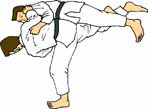 |
||||
|
||||
 |
Martial Art Train Without Pain
By Deb Russell
Reduce Swelling
The universally known treatment of RICE stands for rest, ice, compression, and elevation. The combination of all four reduces swelling. Swelling occurs when blood and fluids leak into the injured area, which is most often a joint. A swollen joint has limited function so it is best to keep your swelling down to a minimum. If you follow the RICE procedure you can prevent further swelling which will increase your recovery time.
- Resting the injury cuts down the circulation to the area. When small blood vessels are torn, movement of the extremity prevents them from sealing up. So to avoid further complications and bleeding keep the injured area still.
- Ice constricts blood vessels when first applied. Icing limits the bleeding into the affected area, which in turn reduces swelling. It also prevents further bleeding which can cause calcium deposits to form in an around injured area later on.
- Compressing the swollen area with an elastic bandage limits the area available for fluid to leak into making it difficult for fluid to leak into area. A bandage will also protect and support the injury. Do not keep it wrapped all the time especially not when sleeping.
- Elevating the damaged area will also decrease blood flow. The heart has to pump harder against gravity if the injured area is raised to a level higher than the heart helping accumulated fluid to flow away from the injured area.
Applying heat to an injury should be avoided. Direct heat will dilate the blood vessels around the injury, leading to more swelling, muscle spasm and increased pain. If the injury does not improve in a day or so following the RICE treatment, have it checked out by a doctor, chiropractic physician or doctor of osteopathy. X-rays may be needed to check for bone fractures or severely torn soft tissues.
Some styles are more contact and fight-oriented and injuries seem to be more common and much more serious (broken nose, toes, ribs etc.) but the frequency of injury does not lessen the pain. Recent research findings have indicated that the injury rate associated with martial arts is comparable to the risk of injury in contact sports like football and rugby, and higher than other popular sports such as running, racquetball, and tennis.
Similarly to those engaged in sports, we martial artists have an addiction. If we miss even one day of training, we feel it will put us behind schedule. We will not be ready in time for our next grading or competition. We must bear in mind that rest is also an important part of your training program and an injury prevention in itself. Rest helps your performance in the long run, while assisting the injury to heal.
If there is pain associated with an injury it is the body's way of telling you that there is something wrong. The pain is a protection device to prevent further damage. Obey your physical warning signs and don't ignore your injury until it becomes chronic. See you doctor or kinesiologist regularly.
This Martial Arts sports injuries article is continued in the following sections:
![]() Back to Stretching Flexibility
Back to Stretching Flexibility
![]() From Sports Injuries to Injury Prevention
From Sports Injuries to Injury Prevention
Sports Injuries are preventable when you take the right precautions. Sports injuries in martial arts are common and similar to those of boxers.
FREE Tae kwon do Clipart
Get martial arts clipart like the one below! 50 + images available for your use. Click the Clipart button and follow instructions to get the password. Your email address will be added to our TkdTimes eZine mailing list.Find a topic...
Belts | Classes | Clipart | Forms | History | Injury Prevention | Kids | Martial Arts |Master | Meditation | Men
Olympic | Philosophy | Self Denfense | Styles | Tea | Techniques | Terminology | Tournaments | Women | Vegetarian
Copyright©
2008-2016 The Taekwondo Network. Always check with a physician before beginning any exercise regimen.
No reproduction of material without express written permission of the webmaster.
Taekwondo top of Page

